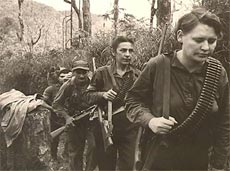Note: Mario Vargas Llosa was WINNER of the Nobel Prize for Literature in 2010.
“You’re my praying mantis, didn’t you know? The female insect devours the male while he’s making love to her. He dies happy, apparently. My case exactly.”
In 19 50, when Ricardo Somocurcio first meets Lily, a “Chilean” exotic who has recently joined the teenage social scene in Lima, Peru, he is fifteen, sure of only one thing—that she is the most bewitching creature he has ever known. His young infatuation eventually develops into a lifelong obsession, and his story of how Lily dominates all aspects of his romantic life for more than forty years shows both the mysterious power of unconditional love and the peril of misplaced devotion.
50, when Ricardo Somocurcio first meets Lily, a “Chilean” exotic who has recently joined the teenage social scene in Lima, Peru, he is fifteen, sure of only one thing—that she is the most bewitching creature he has ever known. His young infatuation eventually develops into a lifelong obsession, and his story of how Lily dominates all aspects of his romantic life for more than forty years shows both the mysterious power of unconditional love and the peril of misplaced devotion.
Lily is a will-o’-the-wisp throughout much of Ricardo’s life, appearing and vanishing, changing names, following the lure of power to revolutionary Cuba, the lure of wealth to Paris and the “horse country” of England, and eventually the lure of both power and wealth to Japan, where her lover is a high ranking yakuza sadist. Somehow, however, she always makes her way back to Ricardo, whom she professes not to love, despite, or perhaps because of, his unquestioned acceptance of her humiliations of him.

From Lima to Paris, London, and Madrid, the story of the “bad girl” and the “good boy” unfolds, exploring all aspects of love and betrayal within the changing settings and political climates of the various countries in which the two have commitments. Whether it be revolutionary Cuba, to which Lily goes as Comrade Arlette; the Tupac Amaru guerilla movement in Peru, where some of Ricardo’s friends battle the government; the French revolutionary movement which brought about the downfall of Charles DeGaulle; or the various United Nations conferences in the 1970s and 1980s, which Ricardo attends as a UNESCO translator, love and politics and violence exist side by side.
Author Mario Vargas Llosa, bases the plot of his book on that of Madame Bovary, a novel that has fascinated him for much of his career and to which he has often referred in essays and interviews. Yet so completely does he make Lily an individual—a femme fatale who forever drops in and then out of Ricardo’s life, no matter where he goes—that the parallels with the Flaubert novel remain in the background. Lily, or whatever name she uses when she bursts in on his life throughout the novel, is a product of her times, a woman whose sexual freedom allows her to pursue whatever pleases her, whether that means having an affair with one of the leaders of the Cuban revolution or engaging in kinky sex with her Japanese gangster lover. At times, and always when she is in dire straits of some sort, she is pleased by Ricardo — though not in love with him, and she has no qualms about using him to solve whatever problems she may have at the moment — and then moving on at her own whim, disappearing unexpectedly and leaving him bereft—as usual.
 Ricardo, for his part, seems content to work as a translator, travel the world in that role for UNESCO, and live what would be, to most people, an empty life without reciprocated love. He sacrifices any kind of long-term happiness in a “normal” relationship for the excitement she occasionally brings to him, unable to stick to his vow that the next time she shows up, he will refuse to respond to her (a trait which may make him an annoying protagonist for some readers).
Ricardo, for his part, seems content to work as a translator, travel the world in that role for UNESCO, and live what would be, to most people, an empty life without reciprocated love. He sacrifices any kind of long-term happiness in a “normal” relationship for the excitement she occasionally brings to him, unable to stick to his vow that the next time she shows up, he will refuse to respond to her (a trait which may make him an annoying protagonist for some readers).
Vargas Llosa, whose fascination with politics permeates many of his novels, broadens the perspective of this novel beyond that of a love story by tying many of the characters’ experiences to revolutionary politics, paying particular attention to the various Peruvian strongmen whose administrations led to the impoverishment of the populace between 1960 and 1990. A candidate for President of Peru himself in 1990, the author draws loose parallels between the bad girl, who represents Ricardo’s constantly dashed (and always revitalized) hopes, and political candidates who promise the world and fail to deliver.

Intense, vibrant prose brings the characters to life, while the author’s ability to set scenes and create periods allows him to trace these characters smoothly through four decades. His peripheral characters—Paul (Comrade Jean), a revolutionary who fights in Peru: Salomon Toledano, a translator who knows twelve languages and loses his head and heart to a woman who feels suffocated by his love; young Yilal, a victim of war who, refuses to speak; and Arquimedes, an intuitive “architect” of breakwaters along the Peruvian coast, are among the several characters who broaden the themes of love and loss by sharing their lives and, sometimes, their deaths in different places throughout the world. Though Vargas Llosa focuses on two people, the bad girl and the good boy, he creates a world around them that is so fully realized that their lives take on symbolic significance: the praying mantis has many parallels in life, love, and politics.
ALSO reviewed here: Vargas Llosa’s DEATH IN THE ANDES, THE FEAST OF THE GOAT, THE DREAM OF THE CELT, THE DISCREET HERO
The photo of the author appears on http://www.shuttervoice.com
The photo of women leading a column of guerrilla fighters in Cuba comes from http://celiasanchez.org
American Lori Berenson, newly released from a Peruvian prison, remains under house arrest in Peru after serving fifteen years of a twenty-year prison sentence for her work with the revolutionary Tupac Amaru guerrilla group. Her photo accompanies this story: http://en.mercopress.com
